
Monogram 1/72 F11C-2 Goshawk
| KIT #: | . |
| PRICE: | $3.00 back when |
| DECALS: | One Option |
| REVIEWER: | Carmel J. Attard |
| NOTES: |

| HISTORY |
Originally developed for the US Army, the Curtiss biplane
served a long and active career with the US Navy and Marines. Although initially
allocated an F- for fighter designation, the Curtiss Goshawk was one of several
dual-purpose aircraft employed by the US Navy in the 1930s. as acknowledged by
the allocation of
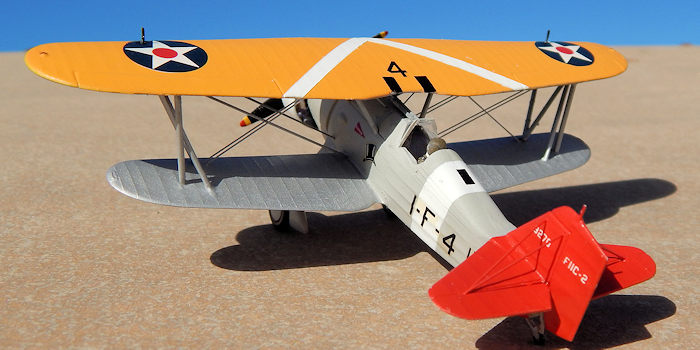 BF
(Bomber/Fighter) designation later in the career. It was essentially developed
from the P6/F6 Hawk series built for the US Army and Navy.
BF
(Bomber/Fighter) designation later in the career. It was essentially developed
from the P6/F6 Hawk series built for the US Army and Navy.
Twenty-eight F11C-2s were ordered in October 1932 and delivery of the first aircraft began in the following April to US Navy squadron VF-1B on board the USS Saratoga. In March 1934 the F11C-2 were reorganized as BFC-2, undergoing modification, which included a semi-enclosed cockpit canopy and built up rear fuselage. Eleven aircraft were transferred to the USS Enterprise in 1938 as the newly formed bombing six. However it remained doubtful that these BFC-2s ever flew off the deck of the carrier. They were replaced by Northrop BT-1s the same time as the enterprise was commissioned. Except for that short five-month period only one squadron flew the aircraft. This was the famous “High Hat” unit VF-1B, which flew the F11C-2 from February 1933 until February 1938.
The F11C-2 was a relatively small aeroplane by today’s standard having a wing span 31.5 feet, and a length of 22 feet 5 inches. It was powered by a nine cylinder 700hp Wright Cyclone engine a top speed of 198 mph with a service ceiling of 24,000 ft. Armament consisted of two symmetrical Browning .30 calibre machine guns and one 500 lb bomb that could be carried in place of the streamlined belly tank.
| THE KIT |
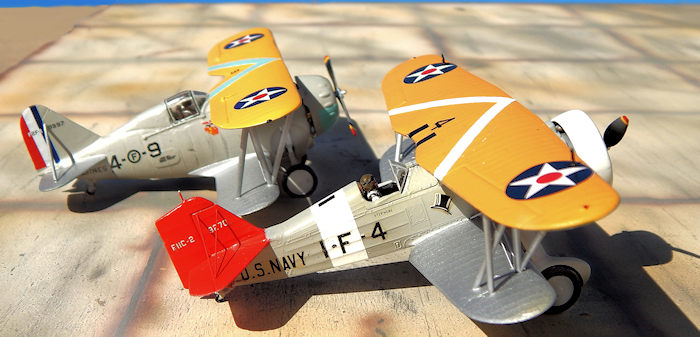 This is an
accurate model of the F11C-2 produced by Monogram that can build into a nice
model. I had the kit for quite a long time but recently I was building kits from
the pre war era of Navy and Marine types and the chance arrived to build the
Goshawk. In spite of age on this model, released in 1968 the kit is well
detailed including an accurate pilot figure. Moulded in silver styrene, with
ample of surface detail to the fuselage as well as the ripple covering on
This is an
accurate model of the F11C-2 produced by Monogram that can build into a nice
model. I had the kit for quite a long time but recently I was building kits from
the pre war era of Navy and Marine types and the chance arrived to build the
Goshawk. In spite of age on this model, released in 1968 the kit is well
detailed including an accurate pilot figure. Moulded in silver styrene, with
ample of surface detail to the fuselage as well as the ripple covering on
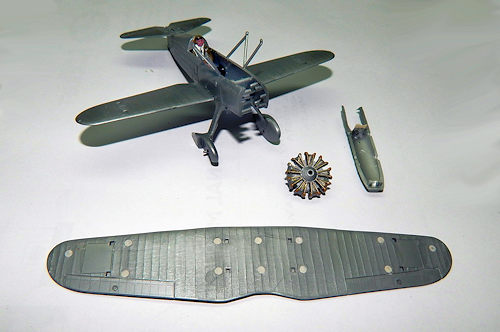 the
fabric wings being quite effective. The only issue with this kit is the repeated
ejector pin marks on the under wing surfaces that required careful filling and
sanding.
the
fabric wings being quite effective. The only issue with this kit is the repeated
ejector pin marks on the under wing surfaces that required careful filling and
sanding.
The twin page instructions contain history of the aircraft, a three-view monochrome plan view depicting the colours of the aircraft, decals placement and four stage assembly diagrams. Decal sheet was well printed and good back then but I have substituted the star insignia with similar size ones from a Micro Scale decal brand.
| CONSTRUCTION |
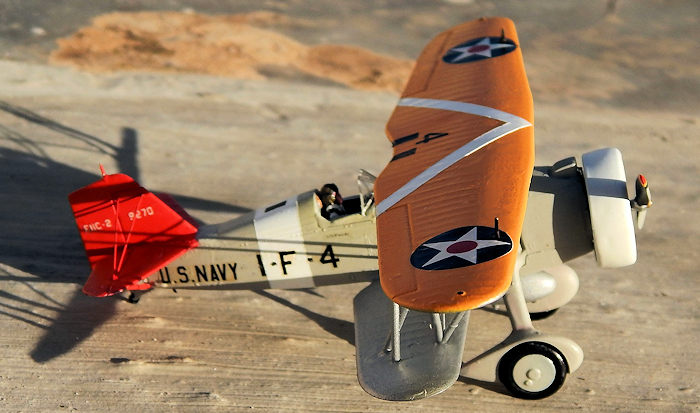 The kit had
the interior painted and crew figure also painted as per instructions and the
fuselage could then be assembled. Instrument panel had the printed decal
attached and fixed in place. A crew seat was added from my spares and the crew
figure glued in place. The right fuselage half was then cemented to the left
half. Lower wing was cemented to the lower fuselage but the belly tank which is
silver painted was to be fitted at the final stage. In the meantime the fuselage
was given the first coat of light gray, an area was then masked at mid fuselage
so that a white bend is airbrushed. This will replace the white decal sheet that
has turned pale yellow with time on it. Tail fin and rudder was cemented to rear
fuselage and tail stabilisers also cemented. The fuselage was now masked and the
lower wing given a coat of silver.
The kit had
the interior painted and crew figure also painted as per instructions and the
fuselage could then be assembled. Instrument panel had the printed decal
attached and fixed in place. A crew seat was added from my spares and the crew
figure glued in place. The right fuselage half was then cemented to the left
half. Lower wing was cemented to the lower fuselage but the belly tank which is
silver painted was to be fitted at the final stage. In the meantime the fuselage
was given the first coat of light gray, an area was then masked at mid fuselage
so that a white bend is airbrushed. This will replace the white decal sheet that
has turned pale yellow with time on it. Tail fin and rudder was cemented to rear
fuselage and tail stabilisers also cemented. The fuselage was now masked and the
lower wing given a coat of silver.
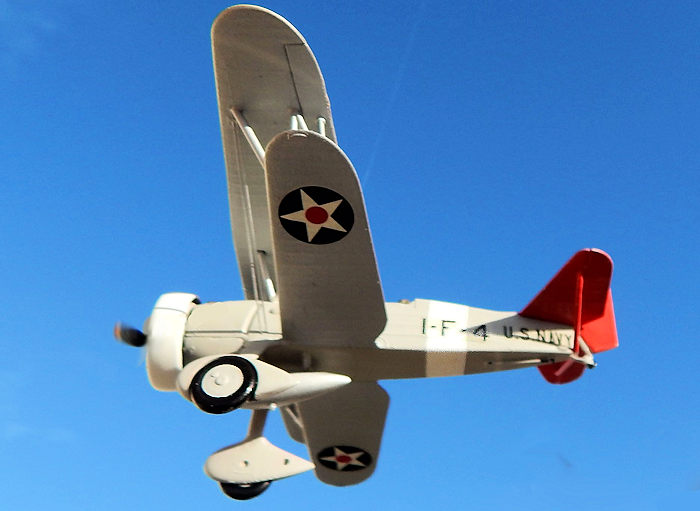 While
assembly was allowed to dry, the five-piece engine and cowling were assembled
after first painting the engine and exhaust. The cowl was painted white. The
propeller blades were also painted light grey at front and black at rear. Prop
tips were painted red yellow and blue and this was also left to fit at a later
stage. Upper wing was first given a undercoat of white and once dry this was
painted orange yellow. The underside painted silver and it was now ready to
lower it on the assembled struts attached to fuselage and lower wing. A good
feature with this kit is the unique and foolproof method for precise alignment
of the wings and landing gear. The cabine struts and landing struts are molded
onto the fuselage halves at the correct angle. This provided automatic and
perfect positioning in areas formerly considered difficult in the assembly of
biplane models. When the wings assembly is strong enough, rigging holes were
marked at appropriate places making reference to photos of the real F11C picked
on line. These were drilled to form double parallel rigging. Fine gauge fishing
line was used for the rigging which were secured with a tiny drop of super
glue.. Areas effected by the drilling holes were sanded and retouched with
paint.
While
assembly was allowed to dry, the five-piece engine and cowling were assembled
after first painting the engine and exhaust. The cowl was painted white. The
propeller blades were also painted light grey at front and black at rear. Prop
tips were painted red yellow and blue and this was also left to fit at a later
stage. Upper wing was first given a undercoat of white and once dry this was
painted orange yellow. The underside painted silver and it was now ready to
lower it on the assembled struts attached to fuselage and lower wing. A good
feature with this kit is the unique and foolproof method for precise alignment
of the wings and landing gear. The cabine struts and landing struts are molded
onto the fuselage halves at the correct angle. This provided automatic and
perfect positioning in areas formerly considered difficult in the assembly of
biplane models. When the wings assembly is strong enough, rigging holes were
marked at appropriate places making reference to photos of the real F11C picked
on line. These were drilled to form double parallel rigging. Fine gauge fishing
line was used for the rigging which were secured with a tiny drop of super
glue.. Areas effected by the drilling holes were sanded and retouched with
paint.
| COLORS & MARKINGS |
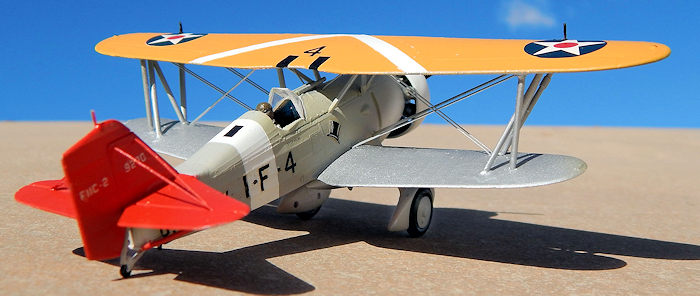 Fuselage
was painted light gray close to Gull gray while wings fabric and control
surfaces painted silver. Tail unit was reed and the fuselage band and cowl being
white. Kit was given an overall coat of Johnsons Klear and decals applied making
use of Micro Scale decals wherever possible. Finally a satin coat of varnish was
applied when all parts were attached to the kit, prop, wheels and the painted
wind screen fixed in place.
Fuselage
was painted light gray close to Gull gray while wings fabric and control
surfaces painted silver. Tail unit was reed and the fuselage band and cowl being
white. Kit was given an overall coat of Johnsons Klear and decals applied making
use of Micro Scale decals wherever possible. Finally a satin coat of varnish was
applied when all parts were attached to the kit, prop, wheels and the painted
wind screen fixed in place.
| CONCLUSIONS |
I Have much enjoyed building this highly admired plane of early 30’s that saw service with the famous “High Hat” squadron aboard the carrier USS Saratoga. I certainly recommend adding this interesting model to those keen on early Navy shipboard types when an opportunity to obtain such a kit comes around.
15 November 2016
Copyright ModelingMadness.com
If you would like your product reviewed fairly and fairly
quickly, please
contact
the editor or see other details in the
Note to
Contributors.